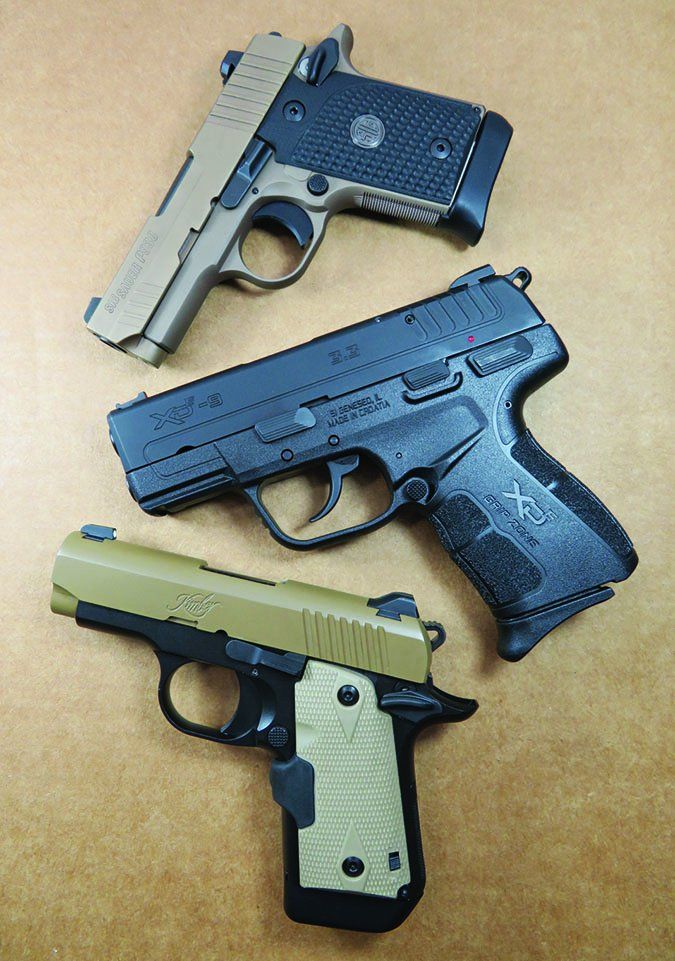
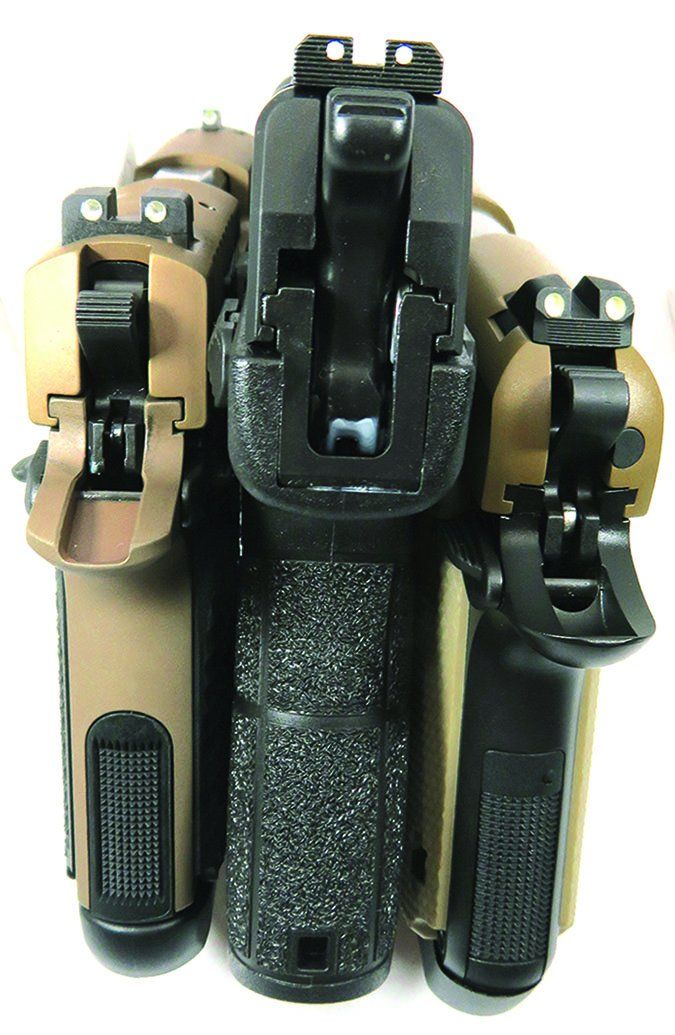
We’ve received emails specifically requesting we review the Kimber Micro 9 and SIG P938. Readers wrote that they “like the idea ofguns made out of actual metal that operate in a very similar manner to a M1911.” So we obliged and assembled a pair of 1911 micro-9mm pistols, a Kimber Micro 9 Desert Tan (LG) with laser grip and a SIG Emperor Scorpion P938. We also added to the mix a new polymer-frame 9mm with a DA/SA trigger, the Springfield Armory XD-E. It is not a 1911 platform at all, but the XD-E is a pistol in the same size class as the Kimber and SIG. All are chambered in 9mm Luger, have barrels that measure from 3- to 3.3-inches in length, employ single-stack magazines, and are designed for concealed carry.
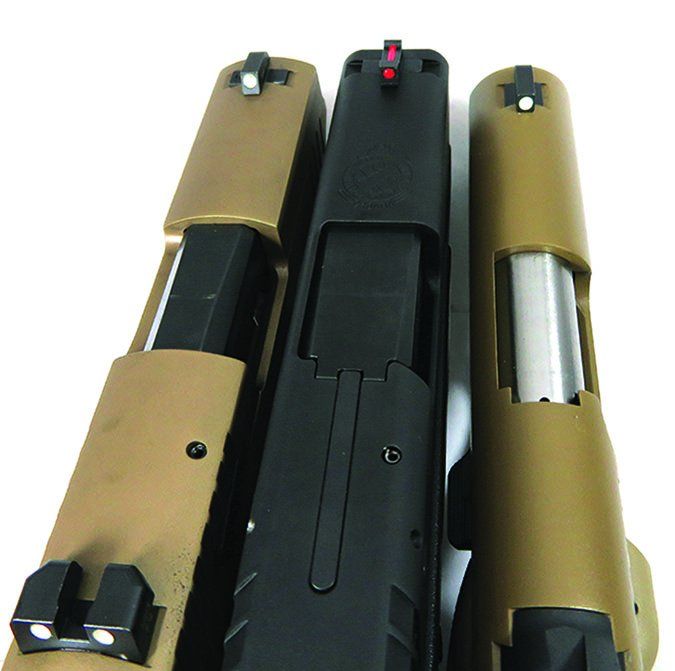
For speed testing, we performed the Bill Drill at 7 yards firing a magazine as fast as we could while still keeping hits in an 8-inch circle. The intent with this drill is to improve speed without eroding accuracy. It also helps us run the pistol dry, check for slide lock back, perform numerous magazine changes, and repeatedly use the slide release as well as test rapid sight alignment and trigger press. We start at the low ready position. All three pistols performed reliably and consistently.
9mm Range Data
| Armscor 9mm 124-gr. FMJ | SIG Sauer P938 Emperor Scorpion | Kimber Micro 9 Desert Tan (LG) | Springfield Armory XD-E 3.3 |
| Average velocity | 990 fps | 1002 fps | 1010 fps |
| Muzzle energy | 270 ft.-lbs. | 276 ft.-lbs. | 281 ft.-lbs. |
| Smallest group | 3.1 in. | 3.4 in. | 2.7 in. |
| Average group | 3.5 in. | 3.7 in. | 3.2 in. |
| SIG Sauer 9mm 115-gr. FMJ | |||
| Average velocity | 971 fps | 1006 fps | 1078 fps |
| Muzzle energy | 241 ft.-lbs. | 258 ft.-lbs. | 297 ft.-lbs. |
| Smallest group | 3.2 in. | 3.3 in. | 2.6 in. |
| Average group | 3.5 in. | 4.2 in. | 3.1 in. |
| Aguila 9mm 124-gr. FMJ | |||
| Average velocity | 968 fps | 1008 fps | 1038 fps |
| Muzzle energy | 258 ft.-lbs. | 280 ft.-lbs. | 297 ft.-lbs. |
| Smallest group | 3.3 in. | 3.2 in. | 2.5 in. |
| Average group | 3.6 in. | 4 in. | 3.2 in. |
| Notes: To collect accuracy data, we fired five-shot groups from a bench using a rest. Distance: 25 yards with open sights. We recorded velocities using a ProChrono digital chronograph. | |||
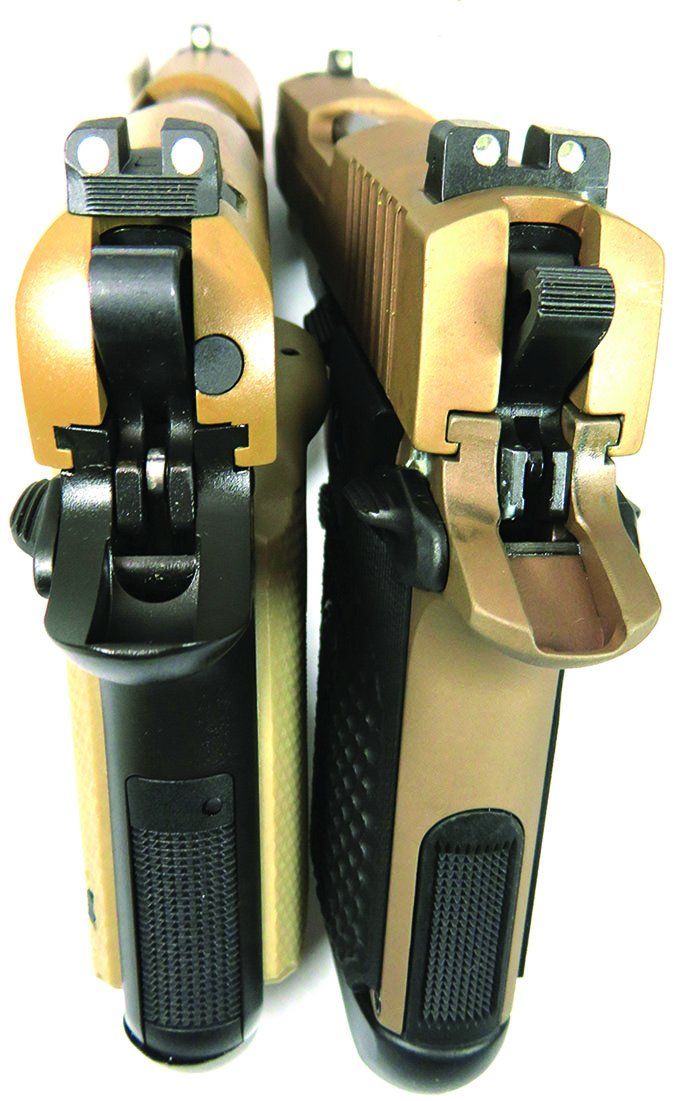
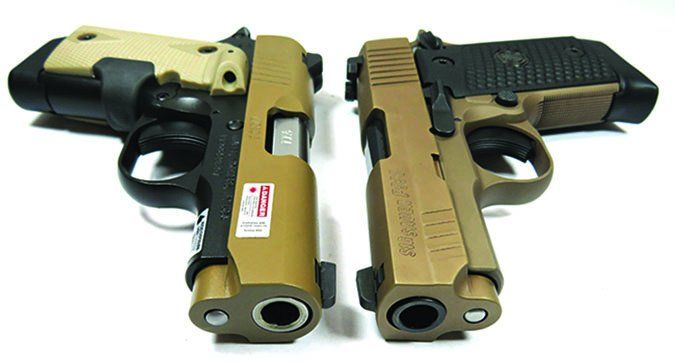
The micro 1911s look similar to a 1911 pistol, but the operating systems are quite different. The Kimber and SIG 1911s are scaled down for conceal carry and have 1911 design elements such as the controls, single-action triggers, and grip angle to create a true back-up-sized 1911. If you are familiar with a 1911, then the transition to one of these micro 1911s will be seamless. The thumb safety, slide release, and magazine release are just like those in the 1911 design. These mini 9mm pistols disassemble with ease, so maintenance is not a chore. We found we liked the mini 1911s in 9mm, and the vote was evenly split between the SIG and Kimber.
The XD-E is an entirely new beast that one tester said looks like a DA/SA trigger mechanism placed in an XD-S receiver mated to a MOD.2 slide. Maybe that’s how it got drawn on a cocktail napkin? Who knows. Our team thought the XD-E needed a few tweaks, though it proved to be a capable shooter. Here are the details on all three.
Kimber Micro 9 Desert Tan (LG) 3300168 9mm Luger, $659
GUN TESTS GRADE: A
The laser grip complements the large sights on this micro pistol. Edges are smooth for concealed carry, and the beavertail protects large hands.
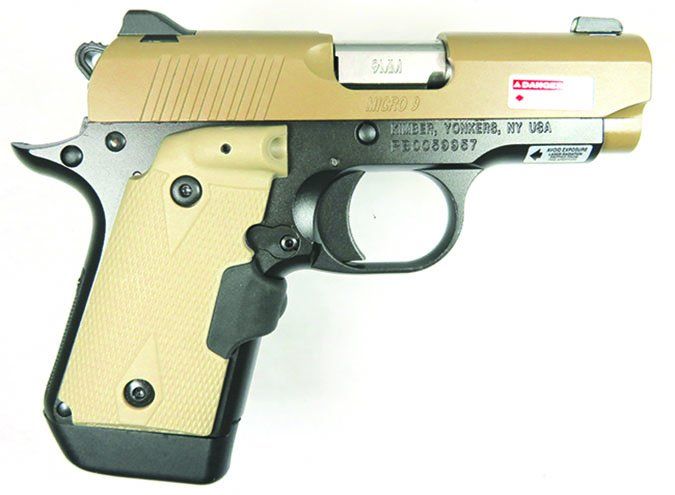
| ACTION | Semi-auto, short recoil-operated, locked breech, single-action semi-auto |
| OVERALL LENGTH | 6.1 in. |
| OVERALL HEIGHT | 4.5 in. |
| MAX WIDTH | 1.2 in. |
| WEIGHT UNLOADED | 15.6 oz. |
| WEIGHT LOADED | 18.1 oz. |
| SLIDE MATERIAL | Stainless steel, Desert Tan finish |
| SLIDE-RETRACTION EFFORT | 14 lbs. |
| RECEIVER MATERIAL | Aluminum alloy; matte black finish |
| FRONT STRAP HEIGHT | 2 in. |
| BACK STRAP HEIGHT | 2.1 in. |
| BARREL LENGTH | 3.15 in. |
| PISTOL GRIP | Checkered Desert Tan, Crimson Trace lasergrips |
| GRIP THICKNESS (max) | 1.1 in. |
| GRIP CIRCUMFERENCE (max) | 5.25 in. |
| MAGAZINE | (2) 6-rd. |
| SIGHTS | 3-dot, laser pointer |
| TRIGGER PULL WEIGHT | 6.4 lbs. |
| TRIGGER SPAN | 2.5 in. |
| SAFETY | Manual thumb lever |
| WARRANTY | 1 year limited |
| WEBSITE | KimberAmerica.com |
| TELEPHONE | (888) 243-4522 |
| MADE IN | Yonkers, NY |
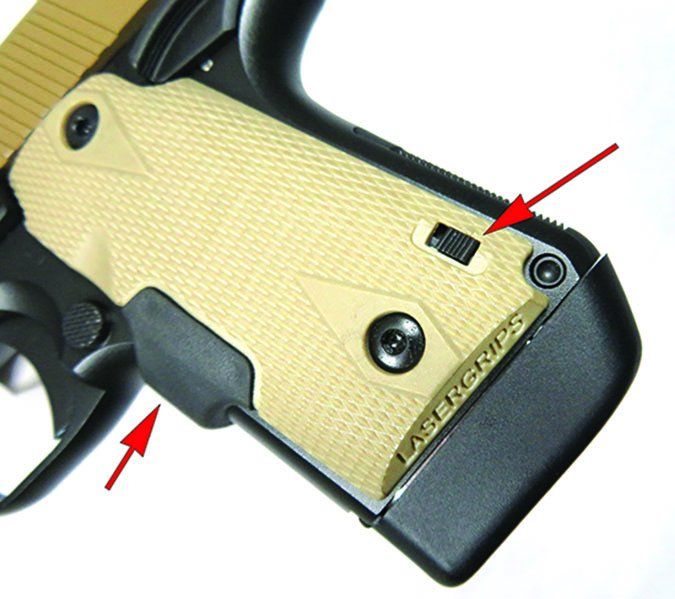
The Micro 9 looks like a shrunken Government 1911 model with its rounded slide top and internal extractor. The fit and finish were well executed and held up during testing. Our sample was outfitted with Crimson Trace Lasergrips, which, in our opinion, enhanced the shootability of these tiny shooters at close range. The pistol came in a soft case with two magazines. The magazines had an extended rubber bumper floorplate that also acted as a finger rest. The floorplate was rounded on all the edges. In fact, all the edges of the Micro 9 were rounded, making it snag free for concealed carry.
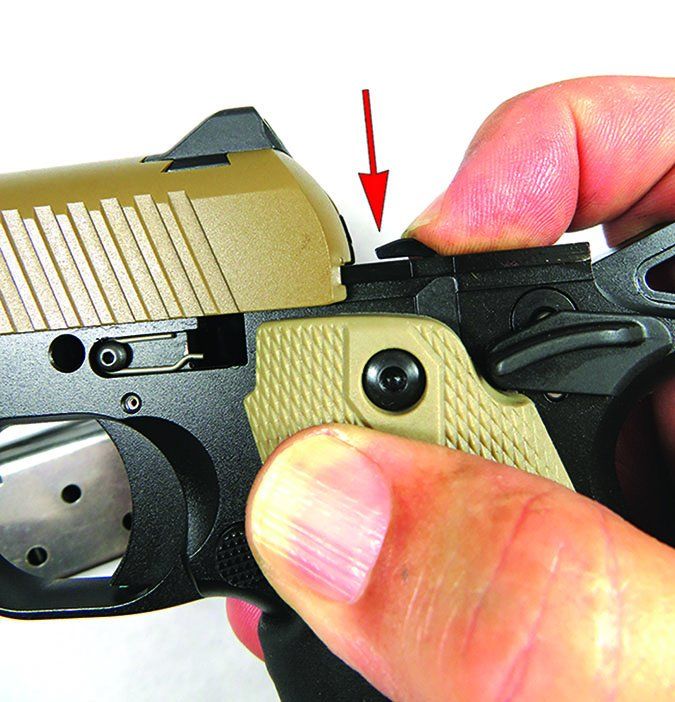
What we liked most about the Micro 9 were the large 3-dot sights. The sights on both the Kimber and SIG were similar in size to sights on a full-size gun, which makes shooting them easier. The Kimber had a left-side thumb safety similar to the set up on a Government 1911A1. It was easy for a right-handed shooter to manipulate the safety with the thumb of the shooting hand, though the SIG provided a bit more safety-lever surface area and was slightly easier to manipulate, we thought.
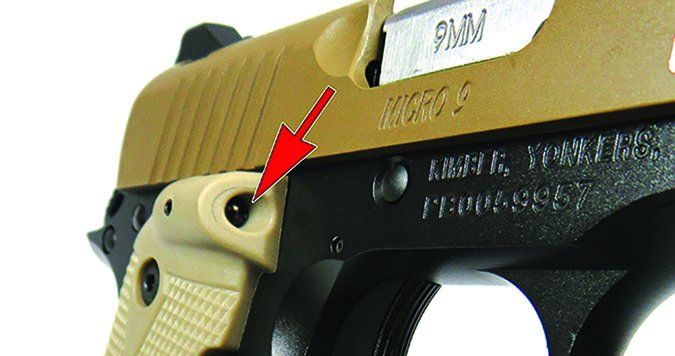
A button on the front strap activates the Lasergrips. When we grasped the pistol, our grip activated the laser. We could also loosen our grip and turn off the laser. We liked the ease of activation and use. A switch on the left grip allows the user to completely turn off the laser. The grip themselves were textured polymer and felt thicker in our hands compared to the SIG. The SIG felt thin and flat. The magazine-release button was simple to work and dumped the stainless magazines freely.
The Micro 9 had slightly more hammer-surface area for texture than the SIG, so it was a bit easier to cock, though both were easy to cock. The Micro 9 also had a slightly larger beavertail than the SIG, so ham-fisted testers felt more comfortable shooting the Kimber. The trigger is serrated, so your trigger-finger pad or first knuckle stuck to it better during recoil. There is a polymer insert in the rear strap with fine checkering which helped keep a grip on the gun when shooting. Field-stripping was easier than on a Government 1911 and was the same for both pistols.
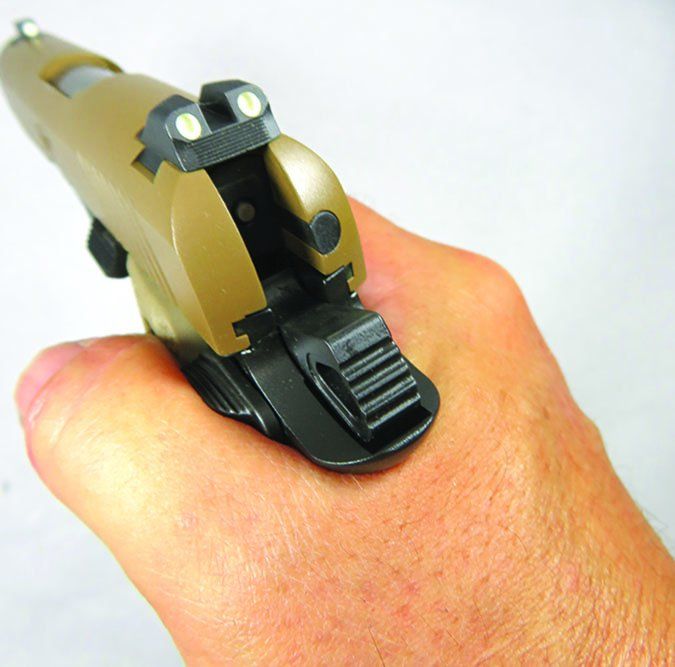
In hand, we liked both the Kimber and SIG, but be aware these lightweight 9mms produce recoil. In our opinion, recoil with all three of these pistols was pleasant, but remember, our North Carolina testers like to shoot 10mm pistols and magnum revolvers. The slide required 14 pounds of force to rack and cock the pistol, which was slightly less than the XD-E and SIG.
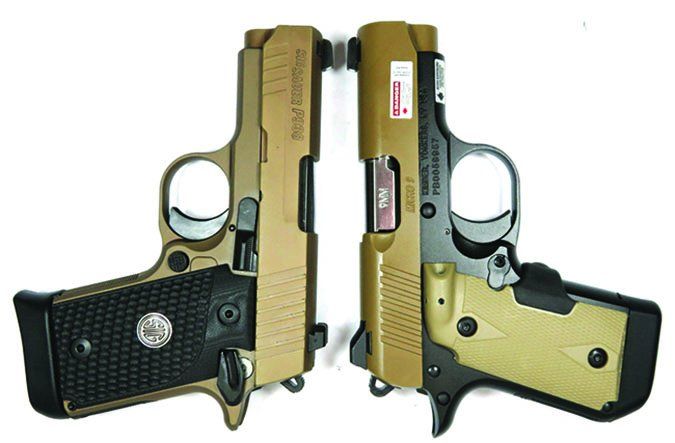
Twenty-five yards is pushing the range of these small pistols, but due to the single-action trigger, large sights, and a rest, we were able to fire 5-shot groups that averaged 4 inches in size. Our best group was with Aguila 124-grain FMJ ammo, a 3.2-inch group. In close-range shooting, we were able to shoot these pistols fast and accurately. Small pistols require a tight grip because they can easily shift in the hand during recoil.
Our Team Said: At close range, the Kimber Micro 9 was accurate and easy to handle. The laser allowed faster aiming in dark conditions, while the full-size sights made aiming easier overall. We like all the smoothed edges and the beavertail.
SIG Sauer P938 Emperor Scorpion 9mm Luger, $639
GUN TESTS GRADE: A
With large sights, a relatively crisp trigger and toothy grips, this pistol was easy to shoot and control.
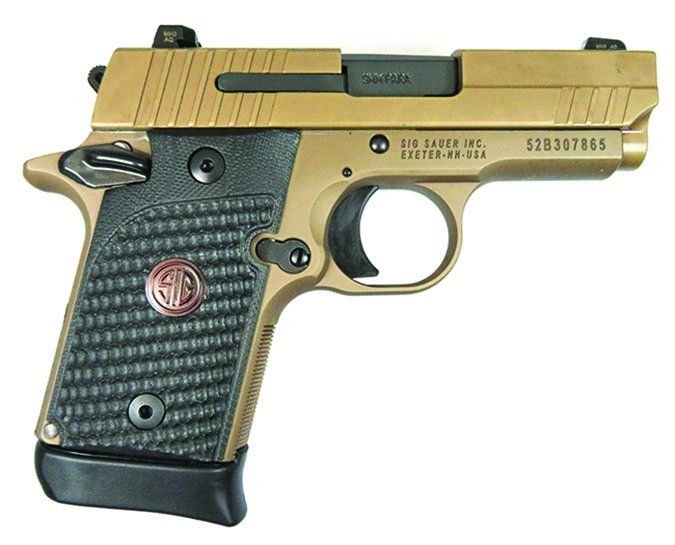
| ACTION | Semi-auto short recoil operated, locked breech, single action |
| OVERALL LENGTH | 6 in. |
| OVERALL HEIGHT | 3.9 in. |
| MAX WIDTH | 1.2 in. |
| WEIGHT UNLOADED | 16 oz. |
| WEIGHT LOADED | 18.5 in. |
| SLIDE MATERIAL | Stainless steel, FDE finish |
| SLIDE-RETRACTION EFFORT | 14 lbs. |
| RECEIVER MATERIAL | Aluminum alloy; FDE PVD |
| FRONT STRAP HEIGHT | 2.1 in. |
| BACK STRAP HEIGHT | 2.4 in. |
| BARREL LENGTH | 3 in., carbon steel |
| PISTOL GRIP | Piranha G10 w/ medallion |
| GRIP THICKNESS (max) | 1.2 in. |
| GRIP CIRCUMFERENCE (max) | 5 in. |
| MAGAZINE | (1) 6-rd. steel; (1) 7-rd. steel |
| SIGHTS | SigLite night sights |
| TRIGGER PULL WEIGHT | 6.6 lbs. |
| TRIGGER SPAN | 2.58 in. |
| SAFETY | Dual ambidextrous lever |
| WARRANTY | Lifetime |
| WEBSITE | SIGSauer.com |
| TELEPHONE | (603) 610-3000 |
| MADE IN | Exeter, NH |
The SIG Emperor Scorpion is aesthetically different than the SIG P938 we tested in our August issue. Our sample has an FDE finish and G10 grips. It came in a hard case with two stainless-steel magazines; one with a finger rest and one without that fits flush in the butt. In the case was a SIG polymer OWB holster. We used the magazine with the floorplate finger rest for most of the testing since we liked this set up the best.
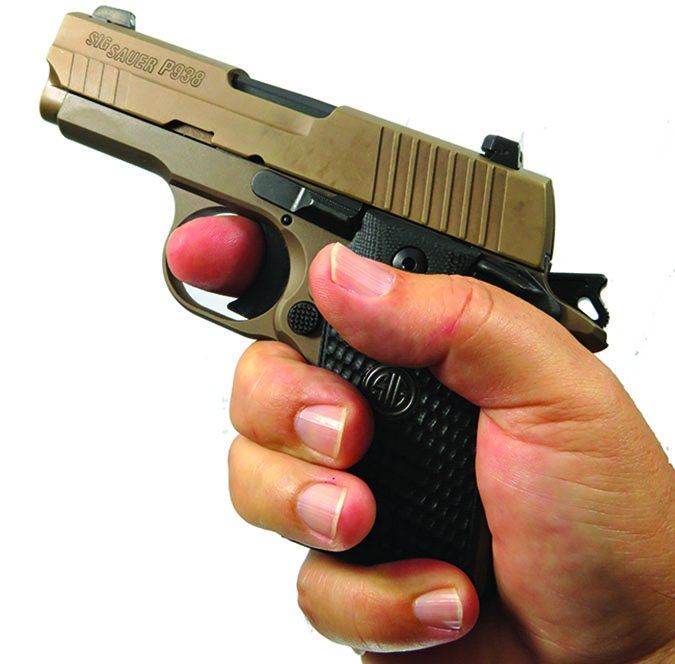
The finish was well executed on the SIG, which was our expectation. We also expected this SIG to run, and it did. But let’s get into what makes the SIG different from the Kimber.
The slide of SIG is shaped like the slide of SIG’s other models, more blocky and squared off than the Kimber. The sights are large and feature SigLite 3-dot night sights. It took about 15 pounds of effort to rack the slide and cock the pistol. We also liked that the SIG had serrations at the muzzle and rear of the slide. The Kimber had serrations only at the rear. We liked being able to rack the slide with a variety of methods. We also found the larger sights allow the user to rack the slide on the edge of a Kydex holster, table top, and nearly any edge. The outside edges of the SIG were sharper and less smooth than the Kimber.
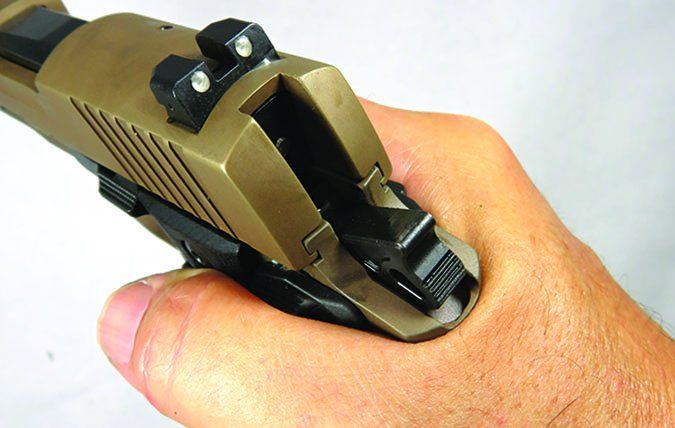
The SIG features an external extractor and an ambidextrous thumb safety that was slightly easier to manipulate than the Kimber. There was a bit more metal to allow testers to flick it on and off without drastically changing the grip. The serrated hammer had a bit less surface area to grasp and cock. The Kimber had a bit more. The beavertail was smaller than the Kimber’s, but none of the testers experienced hammer bite. The face of the trigger was serrated, which we liked when shooting for speed.
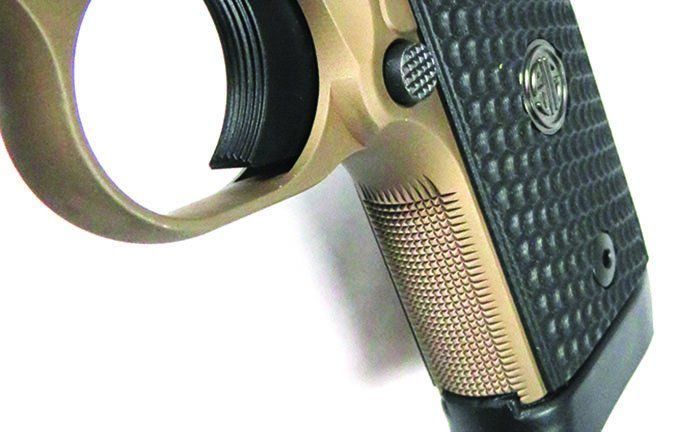
In hand, the SIG much flatter and thinner. We liked the rest on the floorplate because it made the pistol feel like a larger model. What sets both of these micro nines apart from other striker-fired or DAO 9mm pistols are the large sights. It’s a small pistol, but it feels like a large pistol and makes it easier to shoot.
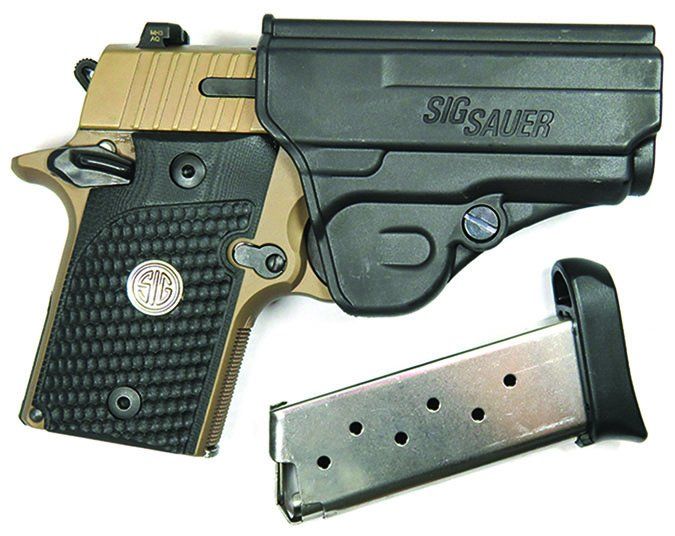
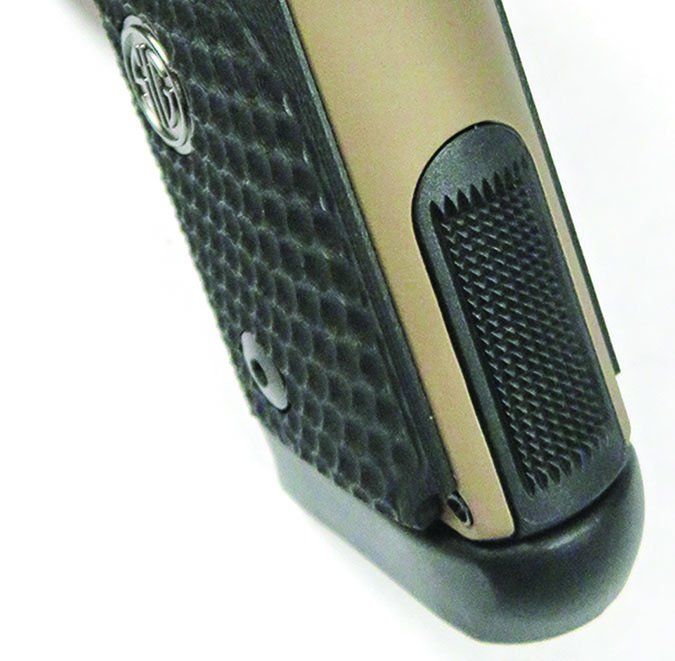
Using a rest and shooting out to 25 yards, the SIG due to its grip, sights, and fairly crisp single-action trigger, was a pleasure to shoot. One tester was able to shoot five rounds into a 3.1-inch group with Armscor 124-grain FMJ ammunition. On average, the pistol grouped at 3.5 inches. Regarding accuracy, we would say the SIG and Kimber were comparable. For the speed-shooting phase of testing, we liked the toothy texture of the SIG because the gun stayed adhered to our hand with no discomfort. The front grip strap was checkered, and it also had a plastic checkered insert in the rear strap. There was lots of texture without the pattern being raspy to the hand. The Kimber laser grips were slicker to the grasp.
Our Team Said: The SIG was felt thinner and had a better texture than the Kimber. We liked the large night sights. In the opinion of half of our testers, the SIG was preferred. The other half would opt for the Kimber. Recoil was pleasant but more noticeable with these lightweight micro nines.
Springfield Armory XD-E 3.3 Single Stack XDE9339BE 9mm Luger, $519
GUN TESTS GRADE: B
The trigger geometry took some getting used to, and the decocker was hard to manipulate in the firing position. Accuracy was good and the trigger break was consistent.
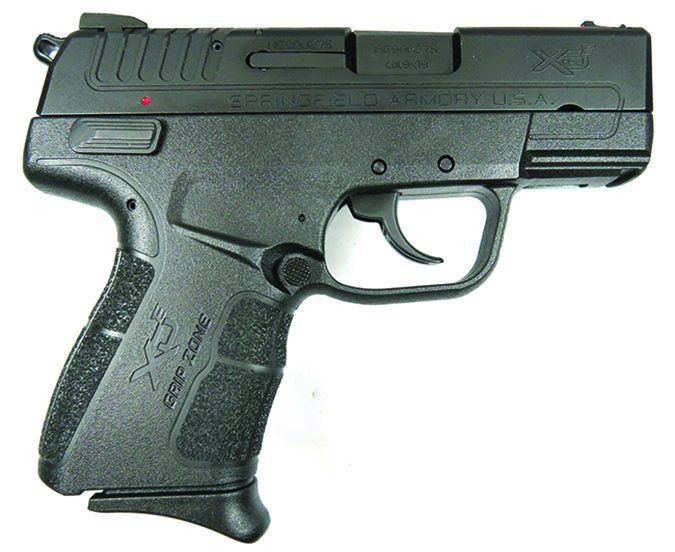
| ACTION TYPE | Short recoil operated, locked breech, DA/SA |
| OVERALL LENGTH | 6.75 in. |
| OVERALL HEIGHT (8-rd. mag) | 5.25 in. |
| MAX WIDTH | 1.25 in. |
| WEIGHT UNLOADED | 25 oz. |
| WEIGHT LOADED (3-rd. mag) | 28.2 oz. |
| SLIDE | Melonite-coated steel, dual spring, full-length guide rod |
| SLIDE-RETRACTION EFFORT | 15 lbs. |
| FRAME | Black polymer |
| FINISH | Black |
| FRONT STRAP HEIGHT | 1.7 in. |
| BACK STRAP HEIGHT | 2.4 in. |
| BARREL | 3.3 in. long, Melonite finish |
| PISTOL GRIP | Textured polymer |
| GRIP THICKNESS (max) | 1 in. |
| GRIP CIRCUMFERENCE (max) | 5.62 in. |
| MAGAZINE | (2) 8- and 9-rd. steel |
| REAR SIGHT | Steel, fixed, white two dot |
| FRONT SIGHT | Steel, fixed blade, fiber optic |
| SIGHT RADIUS | 5.37 in. |
| TRIGGER PULL WEIGHT (DA) | 11.4 lbs. |
| TRIGGER PULL WEIGHT (SA) | 6 lbs. |
| TRIGGER SPAN (DA) | 3.1 in. |
| TRIGGER SPAN (SA) | 2.6 in. |
| SAFETY | 2-position lever |
| WARRANTY | Limited lifetime |
| TELEPHONE | (800) 680-6866 |
| WEBSITE | Springfield-Armory.com |
| MADE IN | Croatia |
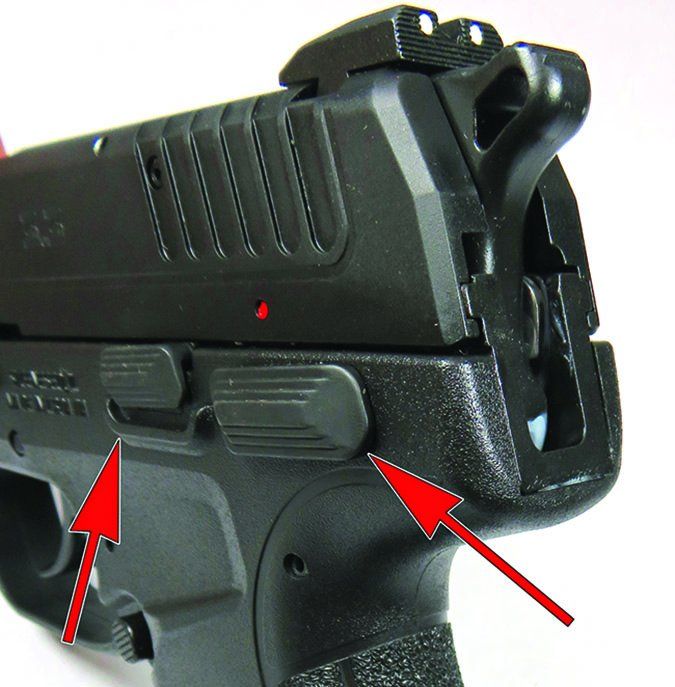
The XD-E is Springfield Armory’s new DA/SA pistol. Known for 1911 pistols and striker-fired pistols, the XD-E is a departure for Springfield. As one of our testers mentioned, the XD-E looks like an amalgamation of Springfield’s striker-fired pistols fitted with a DA/SA trigger system. Pistol-design philosophies fall into three major camps: Single-action triggers, striker-fired triggers, and double action/single action (DA/SA) triggers. All require different training and operating techniques.
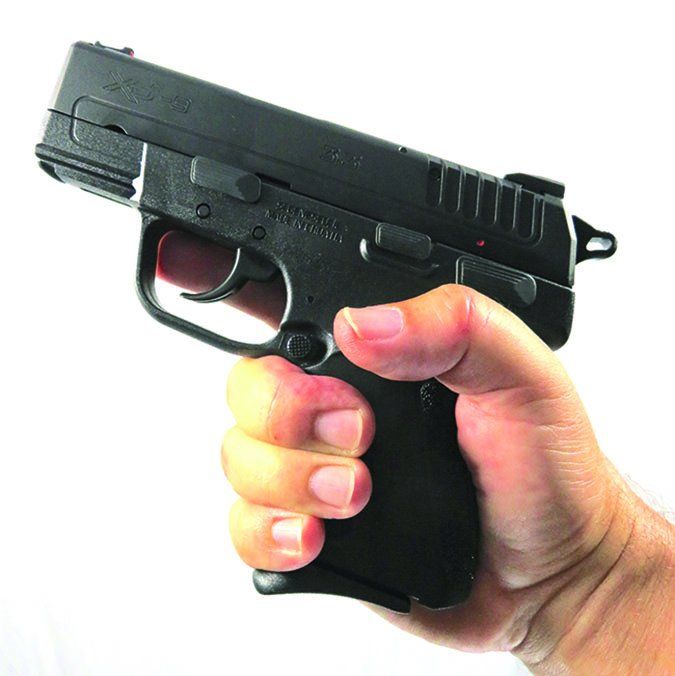
With DA/SA triggers, the ability to load the trigger before the break is an asset, like pressing back on a double-action revolver trigger. While acquiring the target, the shooter can press the trigger, then when on target, press through to fire the pistol. The initial-DA triggers can be an asset because it takes longer to press the trigger. In a high-stress situation, this can help some users ensure against firing a premature shot. The switch from DA to SA can be confusing for some shooters, but for others, it is not. Our test team has a diverse background and thanks to Uncle Sam, some have had extensive training with the DA/SA M9.
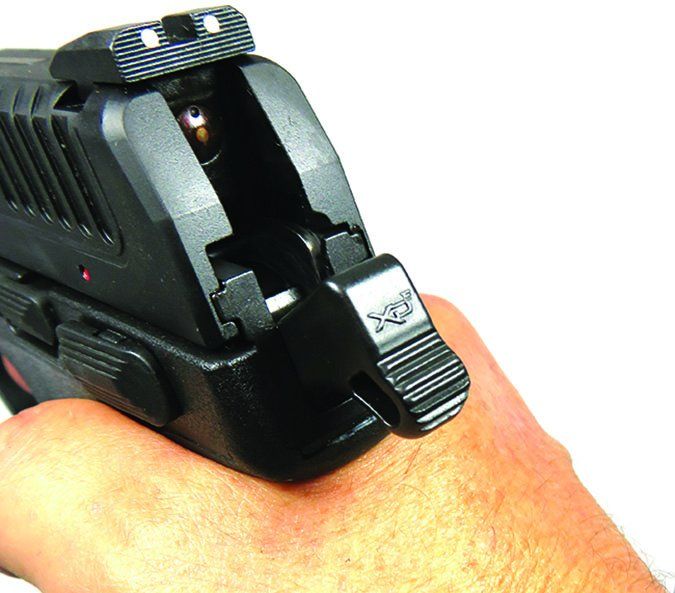
The external hammer of the XD-E provides a simple picture to see if the pistol is cocked or not. What we liked about the XD-E was it could be carried DA/SA or cocked and locked. Due to the smooth trigger press, we’d carry it DA/SA. An ambidextrous thumb control acts as a safety when the hammer is cocked, and it can decock the hammer. Some testers had an issue manipulating the lever, which we’ll get into. The hammer had plenty of texture to grasp and cock with the shooting-hand thumb.
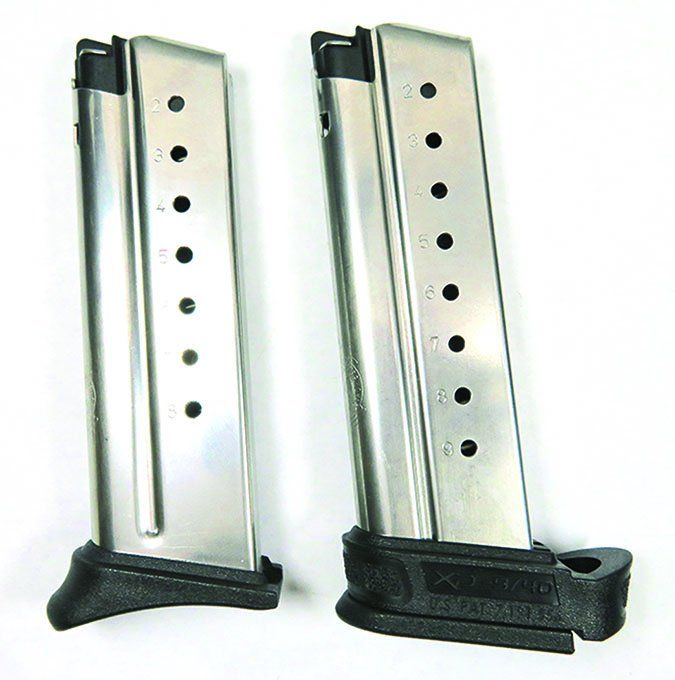
Next, to the Kimber and SIG, the Springfield XD-E was larger due the DA/SA trigger, external hammer, and slide. The XD-E is taller in the shooter’s hand. Another issue some our testers had with the XD-E was the trigger. Testers with fat, sausage-like fingers felt they couldn’t get to the trigger as easily as they could with other DA/SA pistols like those from SIG and Beretta. There is not a lot of space between the front face of the trigger and the inside of the trigger guard. The trigger is curved up in a high arc, which lessens the space. Shooters with average-size hands also found the trigger geometry different, but in use, the trigger was easily pressed to fire the pistol. The looks were a bit deceiving because some testers were able to shoot the XD-E well, while the fat-fingered testers did not have as easy a time. The reach of the trigger is a comfortable stretch for average size hands.
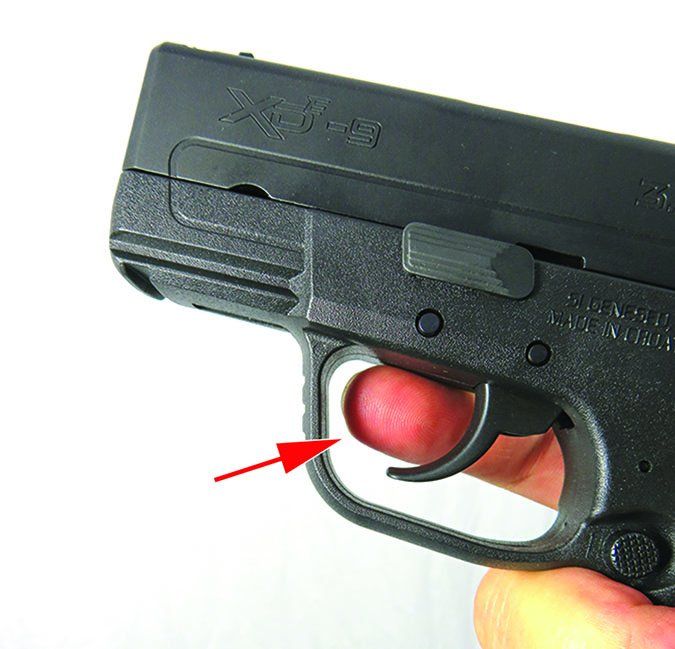
The frame had a Picatinny slot to add a light or laser. The slide has a marking similar to a MOD.2 pistol without the deep-cut sculpting. The red fiber-optic front sight is excellent, while the rear sight is windage adjustable and sits flush with the rear of the slide for maximum sight radius. It is also serrated on the part that faces the shooter to cut sun glare. These were excellent sights, and we thought it was easier to acquire the front sight on target due to the red dot. The front sight is dovetailed in place.
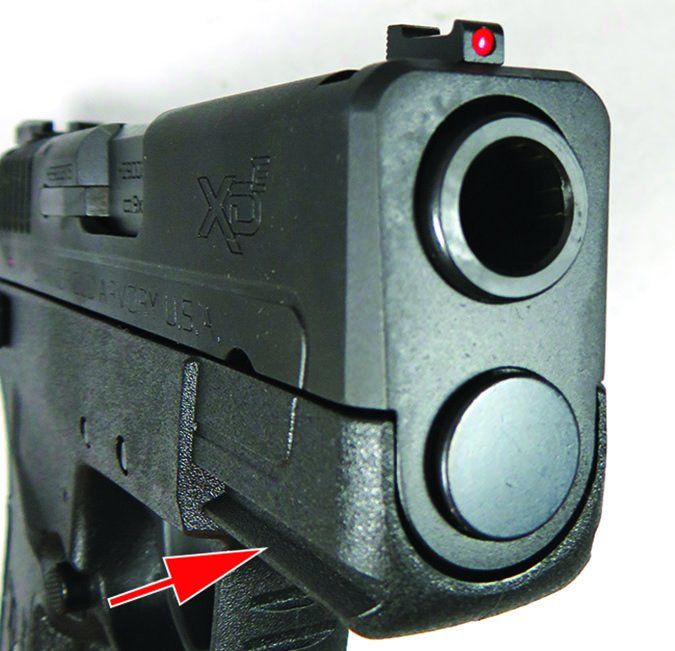
It took 15 pounds of effort to rack the slide and cock the hammer. In hand, the grip felt comfortable, and we liked the textured front and rear grip straps. The front strap had a subtle finger groove, which fit our second and third fingers. At distance, we found the XD-E was a shooter. Our best 5-shot group at 25 yards was 2.5 inches with Aguila ammo. We found the XD-E was the most accurate of all three pistols, with an average accuracy of 3 inches at 25 yards. When shooting for speed, the larger slide, with more surface area, made it faster to grasp and manipulate. The DA/SA trigger is either loved or loathed. The DA pull was long and felt like 11 pounds, though it was a smooth pull. In SA, there was some take up and pull through required, but it broke consistently. The large sights were excellent due to the red fiber optic. The pistol ran flawlessly.
Our Team Said: The XD-E performed well, and we would not hesitate to use the pistol to defend our homes. It was accurate and reliable. Some testers did not like the trigger nor the decocker.
Special thanks to Eastern Outfitters of Hampstead, North Carolina for their assistance. Written and photographed by Robert Sadowski, using evaluations from Gun Tests team testers.































